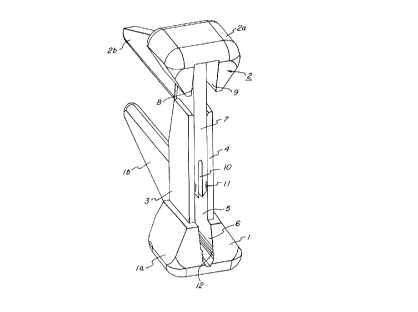Some of the information on this Web page has been provided by external sources. The Government of Canada is not responsible for the accuracy, reliability or currency of the information supplied by external sources. Users wishing to rely upon this information should consult directly with the source of the information. Content provided by external sources is not subject to official languages, privacy and accessibility requirements.
Any discrepancies in the text and image of the Claims and Abstract are due to differing posting times. Text of the Claims and Abstract are posted:
| (12) Patent: | (11) CA 2079695 |
|---|---|
| (54) English Title: | DEVICE FOR SEALING THE END OF A HEAT-SHRUNK SLEEVE |
| (54) French Title: | DISPOSITIF SERVANT A SCELLER L'EXTREMITE D'UN MANCHON THERMO-RETRECI |
| Status: | Deemed expired |
| (51) International Patent Classification (IPC): |
|
|---|---|
| (72) Inventors : |
|
| (73) Owners : |
|
| (71) Applicants : | |
| (74) Agent: | SMART & BIGGAR |
| (74) Associate agent: | |
| (45) Issued: | 1999-03-02 |
| (22) Filed Date: | 1992-10-02 |
| (41) Open to Public Inspection: | 1993-04-05 |
| Examination requested: | 1996-03-13 |
| Availability of licence: | N/A |
| (25) Language of filing: | English |
| Patent Cooperation Treaty (PCT): | No |
|---|
| (30) Application Priority Data: | ||||||
|---|---|---|---|---|---|---|
|
A device for sealing the lend of a heat-shrunk
sleeve surrounding a branching connection of electrical
or optical cables grips the outer surface of the sleeve
between the branching cables and keeps the opposing
surfaces of the sleeve in contact with each other between
the cables, during cooling after the heat-shrinking of
the sleeve. The device has two parallel arms which are
interlocked with each other at one end. The distance
between the arms can be changed in such a way, that the
arms remain essentially parallel at any distance from
each other. The device is preferably installed after
heat-shrinking.
Cette invention concerne un dispositif de scellement de l'extrémité d'un manchon thermorétrécissable protégeant une connexion de câbles électriques ou optiques. Ce dispositif qui prend appui sur la surface extérieur du manchon serre celui-ci entre les câbles raccordés et maintient ses surfaces opposées en contact entre lesdits câbles pendant le refroidissement du manchon thermorétréci. Il comporte deux bras parallèles interconnectés par un bout. L'espacement des bras peut être modifié tout en conservant essentiellement le parallélisme de départ à toutes les distances de séparation. Le dispositif se met en place de préférence après le thermorétrécissement du manchon.
Note: Claims are shown in the official language in which they were submitted.
Note: Descriptions are shown in the official language in which they were submitted.

For a clearer understanding of the status of the application/patent presented on this page, the site Disclaimer , as well as the definitions for Patent , Administrative Status , Maintenance Fee and Payment History should be consulted.
| Title | Date |
|---|---|
| Forecasted Issue Date | 1999-03-02 |
| (22) Filed | 1992-10-02 |
| (41) Open to Public Inspection | 1993-04-05 |
| Examination Requested | 1996-03-13 |
| (45) Issued | 1999-03-02 |
| Deemed Expired | 2005-10-03 |
There is no abandonment history.
| Fee Type | Anniversary Year | Due Date | Amount Paid | Paid Date |
|---|---|---|---|---|
| Application Fee | $0.00 | 1992-10-02 | ||
| Registration of a document - section 124 | $0.00 | 1993-04-20 | ||
| Maintenance Fee - Application - New Act | 2 | 1994-10-03 | $100.00 | 1994-09-02 |
| Maintenance Fee - Application - New Act | 3 | 1995-10-02 | $100.00 | 1995-09-05 |
| Maintenance Fee - Application - New Act | 4 | 1996-10-02 | $100.00 | 1996-09-03 |
| Maintenance Fee - Application - New Act | 5 | 1997-10-02 | $150.00 | 1997-09-22 |
| Maintenance Fee - Application - New Act | 6 | 1998-10-02 | $150.00 | 1998-10-02 |
| Final Fee | $300.00 | 1998-11-16 | ||
| Maintenance Fee - Patent - New Act | 7 | 1999-10-04 | $150.00 | 1999-09-13 |
| Registration of a document - section 124 | $50.00 | 2000-04-26 | ||
| Maintenance Fee - Patent - New Act | 8 | 2000-10-02 | $150.00 | 2000-09-15 |
| Maintenance Fee - Patent - New Act | 9 | 2001-10-02 | $150.00 | 2001-09-18 |
| Maintenance Fee - Patent - New Act | 10 | 2002-10-02 | $200.00 | 2002-09-18 |
| Maintenance Fee - Patent - New Act | 11 | 2003-10-02 | $200.00 | 2003-09-17 |
Note: Records showing the ownership history in alphabetical order.
| Current Owners on Record |
|---|
| RAYCHEM N.V. |
| Past Owners on Record |
|---|
| GRAJEWSKI, FRANZ |
| KABELMETAL ELECTRO GMBH |
| SCHOTTKER, REINHARD |